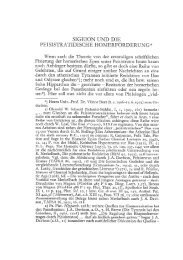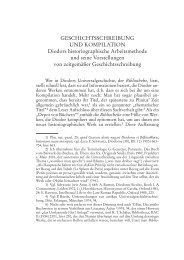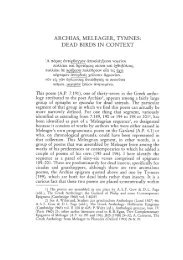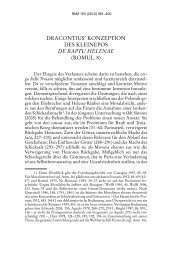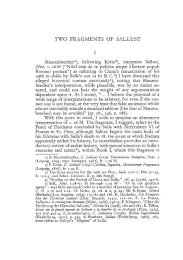THE GEOGRAPHY OF THE PROMETHEUS VINCTUSI
THE GEOGRAPHY OF THE PROMETHEUS VINCTUSI
THE GEOGRAPHY OF THE PROMETHEUS VINCTUSI
Create successful ePaper yourself
Turn your PDF publications into a flip-book with our unique Google optimized e-Paper software.
The Geography of the Prometheus Vinctus 125<br />
from the Alps to the Sea of Azov the poet of the P.V. was foIlowing<br />
some already established geographical conception. As it happens,<br />
the earliest source in which this conception is explicitly attested<br />
belongs to the fourth century B.C<br />
II<br />
It seems to me that many problems in the geography of the<br />
P.V. can be solved if we abandon the presumption that the map of<br />
the world as found in Prometheus' instructions to 10 reflects the<br />
geograrhical knowledge and theory of the fifth-century B.C or<br />
even 0 a some earlier period 16 . Consider, for example, its idea of<br />
Scythia as spreading up to the far north-west of Europe (709ff.).<br />
This idea is in sharp contrast to the archaic and classical one as<br />
represented, for example, in Herodotus, who unambiguously defines<br />
Scythia as lying between the Don and the Danube, that is, to<br />
the north of Lake Maeotis. As for the regions to the north-west,<br />
both the early historians and the poetic tradition that preceded<br />
them seem to have been hardly aware of their existence 17 .<br />
Let us consider now Diodorus' account of an unorthodox<br />
version of the Argonauts' journey back from the Pontus as given<br />
by Timaeus of Tauromenium (second half of the fourth - first half<br />
of the third century B.C): "Not a few both of the ancient [historians]<br />
and of the later ones as weIl, one of whom is Timaeus, say<br />
that the Argonauts ... sailed ... up the Tanais river as far as its<br />
sources, and at a certain place they hauled the ship overland, and<br />
foIlowing in turn another river which flowed into the ocean they<br />
sailed down it to the sea; then they made their course from the<br />
north to the west, keeping the land on the left, and when they<br />
arrived near Gadeira they sailed into our sea."18 It can be seen<br />
16) The latter view was advocated by Bolton 63-64, who sought to reduce<br />
the map of the world suggested by the P.V. to the Arimaspea of Aristeas of<br />
Proconnesus, that is, to the seventh century B.C.; this bias made him deny, contrary<br />
to historical evidence (cf. nn. 3--4 above), any Greek knowledge of the Pontus<br />
prior to Aristeas and even cast doubt on the traditional version of the Argonautic<br />
legend which, as pointed out above, presupposes such knowledge from the earliest<br />
times of Greek history.<br />
17) See Hdt. 4.17-20; 47-58; 99-117; cf. Thomson 60-61. Note that the<br />
barbarian peoples that lived beyond the Scythians are described by Herodotus as<br />
spreading directly to their north and not to the north-west as in later sourees.<br />
18) Diod. Sie. 4.56.3 (= FGrHist 566 F 85); trans. by C.H. Oldfather. Cf.<br />
Scymnus apo schol. Ap. Rhod. 4.282-91.





